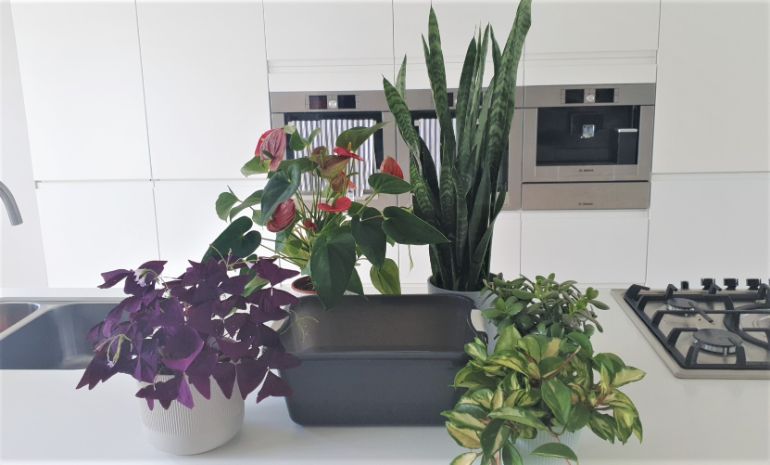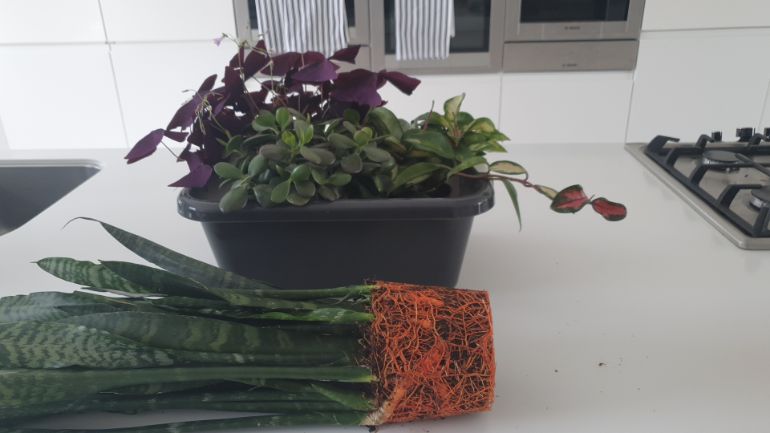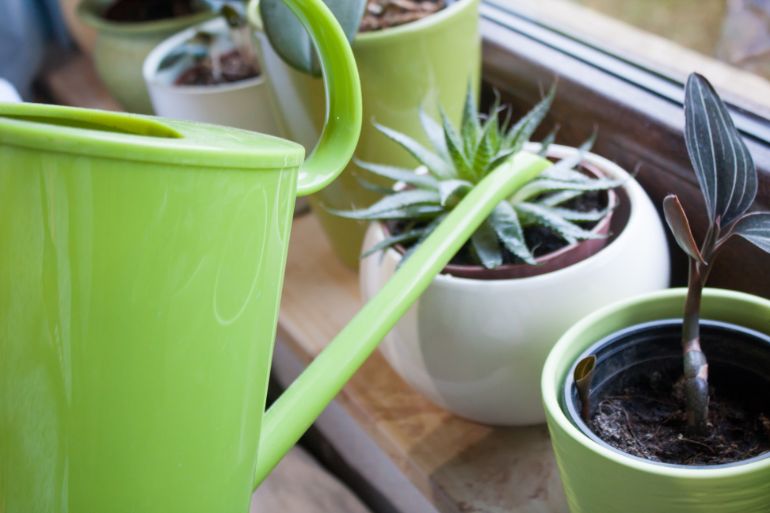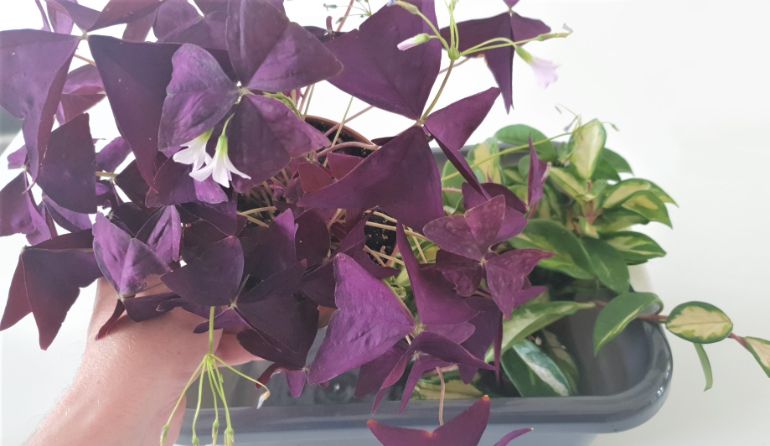Watering is critical to your plants, but it’s not always as simple as it seems. One of the best methods, bottom watering, keeps the foliage safely dry and saturates the soil more evenly than watering from the top. In this article, we’ll explain everything you need to know about bottom watering plants and how to do it successfully.
Bottom watering plants is the process of soaking the soil slowly from below using capillary action. Bottom watering ensures even soil soaking, prevents soil disruption, and reduces the risk of leaf spotting or disease. However, it takes longer to water each plant and there is a risk of overwatering.
Overview of Bottom Watering
Most of us start our gardening journey by watering our plants from the top. This works fine for many plants, but the method has limitations.
Watering from the top down is indiscriminate and can lead to uneven soil moisture. Your plant may seem well-watered, but you might get a surprise if you unpot the plant and check the outer soil. It’s common to find wet streaks with gaps of drier mix.
Bottom watering can be a healthy alternative because it keeps the foliage dry. Wet leaves promote rot pathogens, fungus, or other diseases. Also, water drops can cause indelible spotting and discoloration on the leaves of some plants.
Wet topsoil also provides favorable conditions for the dreaded fungus gnat and other unwelcome pests.
What Is Bottom Watering?
Bottom watering involves putting a shallow reservoir of water under the plant and letting the moisture soak upwards into the soil.
This gravity-defying trick relies upon the magic of soil’s natural wicking action to gradually soak the entire medium.
The method works on both loose and compact soil. It’s best for small- or medium-sized plants that can be moved easily.
How To Bottom Water Plants
- Find a basin or other reservoir large enough to hold your plant(s).
- Place the plant(s) inside and fill the bowl with an inch or so of water.
- Leave the plant in the reservoir long enough for its soil to become thoroughly soaked. Depending upon the soil’s permeability and the plant’s pot size and drainage capacity, the medium should be fully moistened in 10 to 30 minutes.
- There isn’t a strict amount of time you can leave a plant in the water. A half-hour is fine, but it’s not safe to leave them for hours. You can feel the topsoil to make sure it’s moist before removing it from the water.
Pro Tip: If you use a grow pot inside a decorative container without drainage holes, fill the outer container with an inch of water and set the inner pot inside. Voila! Your plant will water itself.

When Should You Bottom Water Plants?
Bottom watering is usually a great way to water, but sometimes it’s especially called for:
1. Certain Plant Species
Bottom watering is great for plants like Peace Lilies that thrive in moist soil. These plants can consume water quickly, making it hard to track soil moisture. Also, their lush leaves can suffer spotting or fungal issues when watered from the top.
Some plants, including Orchids, African Violets, or even the hardy Oxalis, are prone to spotting if water lands on their foliage. Bottom watering makes it easy to keep their leaves dry.
Many epiphytes and other plants which need a very loose mix also do better with bottom watering. Because their mix drains and dries quickly and doesn’t hold much water, they appreciate a soaking that ensures their roots have enough to drink.
Caudex plants and many succulents have fat stems that hold moisture. These don’t need to be watered frequently, but they like a good, brief inundation once they’re ready. Bottom watering fits such plants perfectly.
2. Dry Soil
Bottom watering is definitely the way to go is when the soil has completely dried out. Desiccated soil tends to be ‘hydrophobic’ and actually repels water. If the soil is too dry, water added to the top will just run down the sides without moistening it.
Note: Any time a pot drains too quickly, it’s a signal the soil has dried and is repelling moisture – or has too much aerating material.
A good bottom-up soak will fully hydrate even the driest soil.
3. Root-Bound Plants
As a plant’s roots fill its pot and consume the soil, the mix loses its ability to absorb and retain moisture. The plant will need to be watered more often, and you can’t be sure that moisture has reached the entire rootball. Bottom watering penetrates all the roots.
If the plant is severely rootbound, there will be less soil capillary action to moisten the upper roots, so fill the reservoir higher. Also let a rootbound plant soak for a few extra minutes, since there won’t be much water retained in the scant soil.
4. When You Can’t See The Soil
It can be hard to judge the watering of a lush plant that has overgrown the topsoil. As you fit the waterspout around the foliage and stems, it’s hard to see any missed areas.
This is a job for bottom watering! Place the pot in a tray of water for a soak – once the surface is spongy and moist, you’ll know water has penetrated the entire container.
5. Fungus Gnats
Bottom watering is a tool to fight soil gnats. Damp surface soil is an excellent breeding ground for these annoying pests. Watering from the bottom helps keep your luscious green baby from becoming a gnat farm.
You should monitor the soil while it soaks; it’s better if the water doesn’t wick all the way up to top and work against your purpose. Remove the plant from the reservoir just as the surface starts to become damp. By noting the time elapsed and subtracting a few minutes, you’ll have a precise guide for future waterings.
6. Heavy Soil
It is better to water heavy and/or compact soil from the bottom, and it’s easier too. These semi-permeable soils absorb water slowly and unevenly … it’s easier to set the plant in water and walk away than to trickle water into the pot for twenty minutes.
Common Bottom Watering Mistakes

Forgetting to Take the Plants Out!
The biggest way to mess up with bottom watering is to forget to take the plants out of the reservoir. This is a prescription for root rot, as submerged lower roots will soon drown.
Some growers leave some of their plants in all day or even overnight, but going beyond a few hours is asking for trouble with most species. There is some leeway with many plants, though.
Using Poor-Quality Water
It’s not a good idea to open the faucet and fill up the bathtub with water for your plants unless you’re sure the tapwater (and tub!) are free of contaminants.
The quality of water you use for bottom watering is as important as that sprinkled from the top. The same issues of leaf discoloration or poor growth in sensitive plants still exist.
Tap water often has chlorine – which will gas out overnight – and chloramine, which requires special chemicals to neutralize.
Pro Tip: A few drops of an inexpensive common aquarium dechlorinator will neutralize chloramine in minutes.
Dechlorination won’t solve the issue of heavily mineralized or contaminated water, however. Consider using rainwater, filtered water, or distilled water if needed.
Bottom Watering Pros & Cons
You don’t need to make an absolute decision about which watering method you choose. It’s actually better not to use bottom watering every time. Knowing each method’s benefits and drawbacks lets you make informed decisions.
Pros
Thorough Saturation
Bottom watering ensures the entire soil mass is moistened. Unlike top-down watering that can leave dry spots, bottom-up soaking guarantees even penetration.
Capillary action allows the water to seep into pockets of dry roots. Bottom watering will penetrate heavy or compacted soils, though it may take a little more soaking time.
Rehydrates Dry Soil
If you’ve missed a watering session and your plant is suffering from dry soil, bottom watering is a wonderful restorative. If the plant hasn’t been permanently damaged, it’s the best way to completely revive a wilting plant.
Bottom watering ensures that even the most desiccated parts of the soil are rehydrated. It supplies a quiet, extended drink to a thirsty and appreciative plant.
Doesn’t Risk Foliage
Bottom watering not only avoids spotting of sensitive leaves, it keeps water from sitting on leaves or lingering in joints. This avoids conditions that promote fungus problems or rot.
Not every plant needs such careful treatment if the weather is warm and the foliage can dry quickly. Don’t forget, however, that these are also ideal conditions for fungal growth.
Easy Fertilization
Adding a weak dilution of fertilizer to the reservoir’s water ensures all the roots will be fed. It disperses nutrition evenly through the soil.
If you are watering many plants, there is another advantage of fertilizing through bottom watering. You only have to measure out the formula once! The amount of fertilizer automatically adjusts to the volume of soil in the individual pots by how much it soaks up.
Encourages Natural Root Growth
One problem with top-down watering is that the moisture saturates the surface first: this encourages roots to grow upward to absorb it. Unless water completely penetrates the lower reaches of soil, the plant’s roots tend to gather near the surface – where they are more vulnerable to drying and disturbance.
Bottom watering moistens the soil beneath the plant, so it induces roots to grow naturally downward. Even a short bottom soak that doesn’t reach the top of the soil moistens the soil’s lower regions.
Reduces Soil Gnats And Mites
Soil gnats are a common complaint. Top-down watering ensures they have the moist topsoil they need to proliferate. If you have a gnat problem, try bottom watering before putting toxic insecticides in the soil.
Bottom watering doesn’t flood the soil surface, so the topsoil tends to dry out faster using this method. It would be better not to allow water to penetrate all the way to the surface; but, even so, bottom watering will still help reduce your gnat population.
Minimizes Soil Disturbance
Watering from the bottom leaves the surface soil undisturbed, which is great if you have a top dressing or arrangement you want to keep in place. Bottom watering doesn’t splash seeds out of their furrows or uproot small plants.
Bottom watering is also a solution to the common bugaboo of floating perlite in light soils. With top watering, perlite tends to migrate to the surface and blow around or spill over the rim. Bottom watering doesn’t disturb the soil, so perlite stays buried!

Reduces Risk Of Contagion
One way fungus and other diseases spread from plant to plant is through splashes of water drops. Since there’s no splashing or spraying involved in bottom watering, bottom watering minimizes the accidental transmission of pathogens.
Saves Time
Depending upon how you structure your plant-keeping time, bottom watering can shorten the time you spend watering. It works best if you have a number of smaller pots and a basin large enough to soak them together at once.
Instead of going from plant to plant, giving each a series of sips, simply fill the reservoir and put in the pots. You are then free to do other tasks while they soak. Don’t forget to set a timer!
Cons
Takes Too Long
Though we covered how bottom watering can save time, it really can go either way depending upon the situation. Bottom watering requires less actual hands-on time, but the soaking process itself takes longer.
If you have somewhere you need to be soon, it’s not the best time to haul out your soaking basin. Also, remember that bottom watering requires you to be available to take the plants back out.
Doesn’t Flush The Soil
The most definite drawback to bottom watering is that it doesn’t flush the soil. Since residue from unused fertilizer and other chemicals stays in the pot, it can toxify the soil over time.
Flushing is a natural advantage of top-down watering. If extra water is allowed to flow through the container’s drain holes, watering from the top “washes” the soil and removes unwanted residues.
This is an example of why it’s important to understand both watering methods and what they are best for. If you regularly bottom water your plants, alternate with a monthly top-down flush to keep the soil well rinsed.
Bottom Watering Tips
- Plants in large containers will take longer to saturate than small ones, so group them accordingly.
- Plants in terracotta pots take longer to finish soaking than ones in plastic containers.
- Don’t forget to empty any caches after watering so the plant isn’t sitting in water.
Common Questions
Which Plants Are Best For Bottom Watering?
You can successfully bottom water any plant, but some will benefit more than others. It’s effective for rootbound plants or those in compact soil, or for species that spot easily or are vulnerable to fungus if they get wet.
Bottom watering can be a game-changer for species that need a lot of moisture but are prone to rotting at their base. Begonias can fit this description. Bottom watering doesn’t concentrate water at the top, so it helps the stems avoid rot.
How Should I Apply Fertilizer When Bottom Watering?
You should dilute any commercial fertilizer to a half or even a fourth the label’s recommendation as a rule. You should do the same for water used in your reservoir.
Add the appropriate dose of fertilizer according to the volume of water, mix well, and soak!
Will Bottom Watering Lead To Overwatering?
As long as you remove your plants from the reservoir once the soil is saturated, there is no more risk of overwatering than when using a top-down method.
Overwatering usually happens by watering too often or leaving the plant in wet soil for long periods, not by watering too much in a single session.
Should I Use Bottom Watering If My Soil Has Peat?
Yes! Peat is difficult to hydrate when dry. It holds water well once it’s moist – but peat actually repels water when dry.
Peat can develop persistent dry areas under a top-down watering routine. If your soil includes peat moss, it’s a good idea to bottom water every few weeks to make sure the mix stays completely saturated.
You may like to consider using alternatives to peat, as there are significant environmental concerns with the ongoing use of peat in the gardening industry. Other organic soil components have better water absorption characteristics.
Last Word
Personally, I like to use a combination of bottom watering and top-down watering. It all depends on the individual plant and its needs. As long as you are able to confidently identify when your plant needs water, and effectively soak the soil evenly when watering, both are good options.
If you’d like to learn more bout how to keep your houseplants thriving, have a look at some of my other articles below. Alternatively, check out my book, “Houseplants Made Easy“. I cover everything you need to know to grow beautiful houseplants that will thrive year after year.

